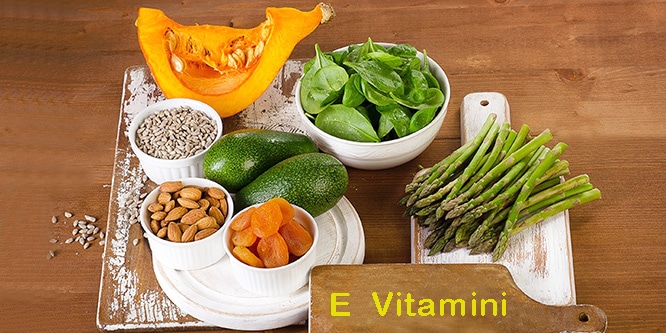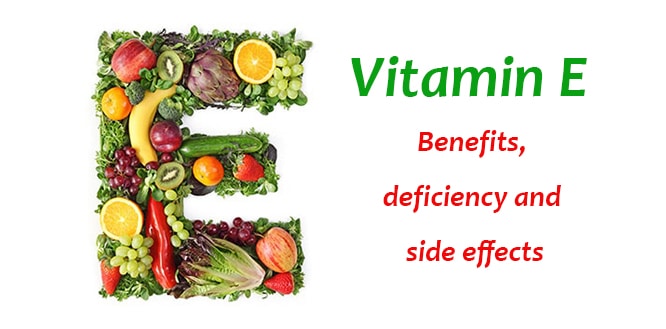Vitamin E is one of the basic vitamins that protects the cardiovascular system health and prevents cancer. It is found in many foods such as vegetable oils, green leafy vegetables, avocados and nuts and can also be taken as a food supplement if necessary. This vitamin, known for its anti-aging properties, protects the skin and hair health and keeps the immune system strong. According to recent studies, it is found that this vitamin is good for Alzheimer Patients. Vitamin E deficiency wouldn’t be seen in healthy-fed people. To experience such a problem, there must be an underlying medical cause, especially a genetic factor.
Table of Contents
What is vitamin E?
Vitamin E is one of the essential vitamins with antioxidant properties that meet our body’s needs. It consists of eight different components with various biological activities. Alpha-tocopherol is one of those components that meets human needs most. It helps to protect our cells from the harmful effects of free radicals. Since it is one of the fat-soluble vitamins, it is stored in tissues, kidneys, heart, muscles, adrenal glands and liver to be used as needed. It is resistant to heat and cooking.
Benefits of Vitamin E
Vitamin E acts as an antioxidant that helps to protect cells from damage caused by free radicals. Normally, our body can tolerate free radicals, but when our cells are extremely exposed to these compounds, they oxidize and accelerate the aging process. Healthy cells weaken then broken.
This increases the risk of health problems such as cancer and cardiovascular diseases. In order to have an immune system capable of fighting against bacteria and viruses, our body needs the support of vitamin E. Another task is to ensure that our cells interact with each other and fulfill many important functions.
- Strengthens the immune system
- Helps to the formation of red blood cells
- Prevents coagulation, regulates blood circulation
- Protects against cardiovascular diseases
- Regulates cholesterol
- Prevents atherosclerosis and thromboembolism
- Reduces high blood pressure, prevents capillary diseases
- Protects against cancer because it can prevent tumor formation
- Protects cell structure by renewing cells
- Accelerates healing of wounds and repairs scarred tissue.
- It helps to store iron and selenium with vitamins A and K.
- Help to overcome early symptoms of menopause in women
- Reduces menstrual pain
- Delays diabetic complications (especially ophthalmic complications)
- Good for eye health
- Can prevent anemia and respiratory distress in infants with low birth weight

- Provides structural and functional maintenance of the skeleton, heart and smooth muscle
- Relieves leg cramps
- Decelerates the symptoms of Alzheimer’s disease and slows down the progression
- Improve male sexual performance
- Good for skin problems, beautifies the skin
- Protects hair health
- Delays aging process
- Protects the body against toxins
Foods containing vitamin E
- Nuts such as, almonds, sunflower seeds, pumpkin seeds, nuts, walnuts
- Vegetable oils such as olive oil
- Vegetables such as spinach, lettuce, cress, cabbage, broccoli, pumpkin, celery
- Fish such as tuna, salmon, sardines and anchovies
- Fruits such as Banana, kiwi, avocado, mango
- Tomato, Potato
- Grains, Butter,
- Red meat, eggs
The amount of vitamin E in some foods
- 100 gr. sunflower oil – 40 mg.
- 100 gr. almond – 30 mg.
- 100 gr. olive oil – 15 mg.
- 100 gr. nuts – 15 mg.
- 100 gr. peanuts – 10 mg.
- 100 gr. avocado – 2 mg.
- 100 gr. spinach – 2 mg.
- 100 gr. broccoli – 1.5 mg.
- 100 gr. tomato – 0.5 mg.
How much vitamin E should be taken per day?
Adults older than 14 years should take 15 mg per day, pregnant women 15 mg per day, lactating women take 19 mg vitamin E per day.
The daily vitamin E needs of children’s are as follows:
- 0-6 months: 4 mg
- 7-12 months: 5 mg
- 1-3 years: 6 mg
- 4-8 years: 7 mg
- 9-13 years: 11 mg
How can the daily vitamin E requirement be met?
Anyone with a healthy diet, takes enough amount of vitamin E they need daily from the foods they eat. However, if your life speed prevents you having balanced diet, you can add foods containing vitamin E to your daily diet very easily by using your creativity.
- A handful of pumpkin seeds or nuts as snack.
- Salad with olive oil, tomatoes and plenty of green leaves.
- You can make cabbage or spinach salad and add hazelnut and olive oil to the sauce.
- You can eat fish twice a week, i.e. the tuna fish is very rich in vitamin E.
- Vegetables such as broccoli, spinach and chard with olive oil on them.
- You can prepare a salad with grated celery, yoghurt, olive oil and garlic salad
Is it harmful to take high amounts of vitamin E?
It is not very common to take high amounts of vitamin E from food. However, the use of long-term or high doses as a food supplement may cause some health problems.
Vitamin E has the ability to store surplus in the body. If stored in large quantities, it can cause gastrointestinal disorders and damage to the digestive tract. Due to its anticoagulant property, intake of high doses may cause internal hemorrhage, especially in patients with cardiovascular problems.
Therefore, it is not recommended to take with aspirin alike anticoagulants. There may be a risk of hemorrhagic stroke due to rupture and arterial bleeding in the brain.
Causes of vitamin E deficiency
Although vitamin E deficiency is usually rare, it can be seen in people who are insufficient and unhealthy, especially those who have fat diet. Other than that, the main causes are genetic and some of the diseases.
Genetic
One of the main reasons. Individuals might have rare hereditary diseases. Of these diseases, ataxia associated with vitamin E deficiency and abetalipoproteinemia is chronic and results in extremely low levels of vitamin E.
Medical conditions
Our body needs fats to properly absorb vitamin E. Vitamin E deficiency can be caused by diseases including pancreatic inflammation, celiac disease, cholestatic liver disease, Crohn’s disease, short bowel syndrome and cystic fibrosis that significantly reduce the absorption of fat.
Vitamin E deficiency is also common in premature infants and infants with low birth weight and is particularly risky in premature babies, because the non-mature digestive system can lead to hemolytic anemia that destroys the red blood cells by inhibiting the absorption of fat and vitamin E.
Diseases caused by vitamin E deficiency
- Atherosclerosis
- Nervous system problems
- Liver and kidney disorders
- Infertility
- Hemolytic anemia
- Cardiac Arrhythmia
- Some cognitive disorders and dementia
- Cataract or blindness
Symptoms of vitamin E deficiency
- Difficulty in walking or coordination
- Muscle pain or weakness
- Loss of muscle mass
- Difficulty in cognition and focusing
- Visual impairments
- Weakening of the immune system
- Digestive problems
- Skin problems
- Hair loss
Vitamin E test
This test is done to measure the level of vitamin E in the blood. The normal level is usually 5,5-17 mg / L. This level may be different for premature infants and children under 17 years old. Some laboratories may give slightly different results. In the presence of less than 4 mg / L of vitamin E in an adult’s blood, supplementation may be necessary.
Vitamin E deficiency treatment
If you notice symptoms of vitamin E deficiency, you should definitely not take vitamin supplements without consulting an internal medicine doctor. The doctor may prescribe you one of the appropriate doses of vitamin E supplements, considering your current conditions. With this treatment, your symptoms may be relieved and your vitamin E values may reach normal levels. However, if the treatment is not applied, the symptoms may worsen over time and this may cause complications and affect your quality of life.
Whom should be given vitamin E drugs?
- Those who with impaired intestinal fat absorption
- Low weighted or premature infants
- Those who with chronic illness causes vitamin E deficiency such as Celiac disease, Crohn disease
- For those who with muscle weakness
- For those with gastric surgery
- Women in menopause
- Women having painful menstruation
- Those who having intensive training
This vitamin can be found in pharmacies in the form of chewable tablets, soft capsules and vials. Do not use any other dose than the doctor’s recommended. Some studies show that high doses can increase the risk of death and cause other serious complications. It is recommended not to take more than 400 mg by people with cardiovascular disease or diabetes as it may impair the body balance as a strong source of antioxidants.
Side effects of vitamin E drugs
Diarrhea, nausea and cramps, fatigue, weakness, headache, blurred vision, bleeding, redness of the skin and bruising.
Considerations when using vitamin E supplements
- Pregnancy: Safe for pregnant women if the recommended daily amount is used. However, since recent research focuses on the possibility of damaging the fetus, vitamin E supplements should not be taken in early periods of pregnancy without consulting the doctor.
- Breastfeeding: A recommended daily amount is safe when taken orally.
- Children: The safe dose of vitamin E for children varies by age. Therefore, dose adjustment should be made under the supervision of the doctor.
- Diabetes: Vitamin E can increase the risk of cardiac failure in people with diabetes.
- Heart attack: Heart attack patients should not take high doses of vitamin E.
- Vitamin K deficiency: Vitamin E can worsen coagulation problems in people with very low levels of Vitamin K.
- Retinitis pigmentosa (night blindness): Vitamin E supplements should not be taken because it may accelerate vision loss in people with eye diseases.
- Bleeding disorders: Vitamin E may worsen bleeding disorders.
- Head and neck cancer: Vitamin E should not be supplemented with more than 400 mg as it may increase the likelihood of relapsing of cancer.
- Prostate cancer: There is concern that taking vitamin E would increase the likelihood of prostate cancer development.
- Stroke: Vitamin E can increase the risk of death in people with a stroke history.
- Surgery: Vitamin E may increase the risk of bleeding during and after surgery. Vitamin E should be discontinued at least 2 weeks prior to a planned surgery.
Interactions of vitamin E supplements with other drugs
Vitamin E supplements have the potential to interact with various drugs. The most important of these are:
- Anticoagulant and antiplatelet drugs: Anticoagulants prevent blood clotting. Antiplatelet drugs reduce the number of thrombocytes in the blood.
- Simvastatin and niacin (B3): Both drugs are usually used to decrease cholesterol levels.
- Chemotherapy and radiotherapy: Oncologists often recommend not to use antioxidant supplements during chemotherapy or radiotherapy because they can reduce the effectiveness of these treatments.
Vitamin E in cosmetics
Vitamin E is used in the cosmetic industry to help protect the skin against aging, inflammation and sun damage. It also contributes to a healthy, vivid and strong appearance of the hair.
Vitamin E for skin health
It eliminates the brown spots that appear on the face, moisturizes the dry skin and lips, and strengthens the nails.
Facial mask recipe with vitamin E
Mix 1 vial of vitamin E and 1 teaspoon of apricot kernel oil then apply the mixture to your face. Leave for 20 minutes and wash your face with warm water. You can apply this cure 1-2 times a week.
Vitamin E for hair health
It feeds the hair roots, repairs the damage, prevents the hair from being damaged and help it to gets healthily longer. It also improves blood circulation in the scalp, cures dry and limp hair, and prevents whitening of the hair.
Hair mask recipe with vitamin E
In a bowl, heat two tablespoons of olive oil until it becomes warm. Break 1 vitamin E vial into it. Apply this mixture to the hair roots by massaging to your scalp and leave it 30 min. to soak. Then wash your hair. You can apply this cure 2-3 times a week. Do not apply the vitamin E vial directly to your skin and hair as this may cause irritation and rash. Dilute it with a vegetable oil such as olive oil or coconut oil. Also check: Vitamin E





Very interesting